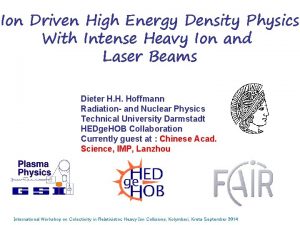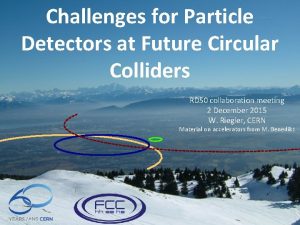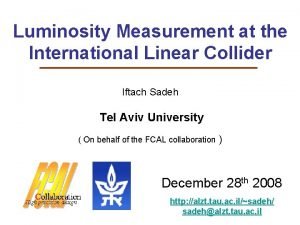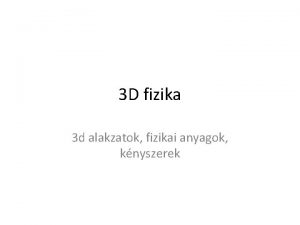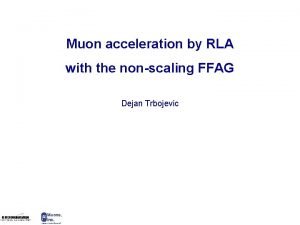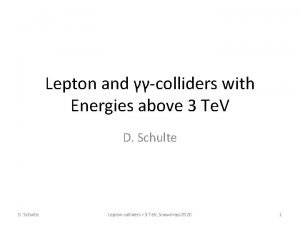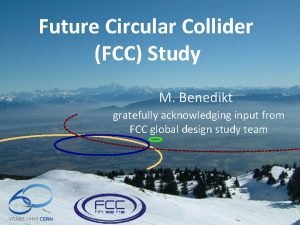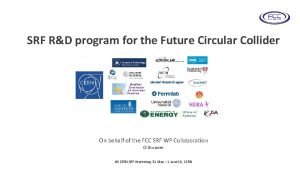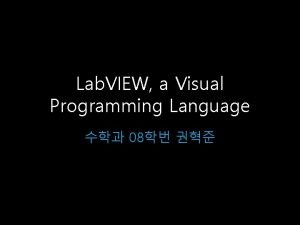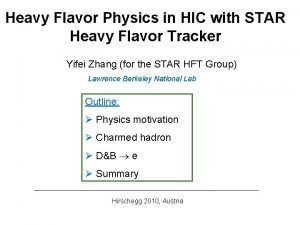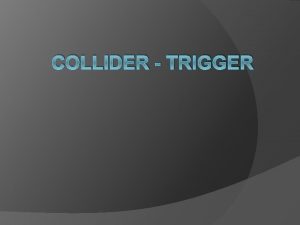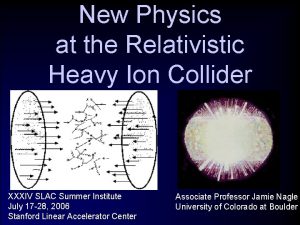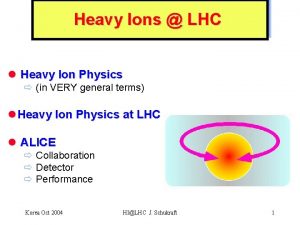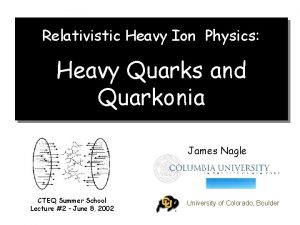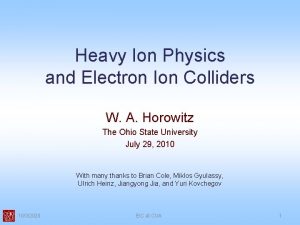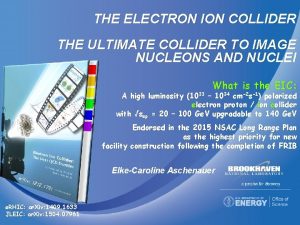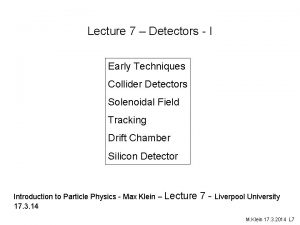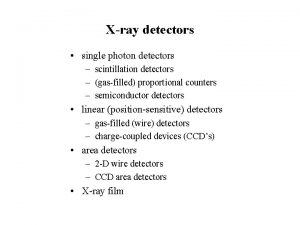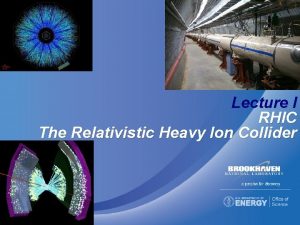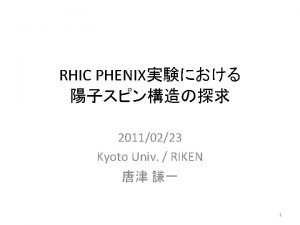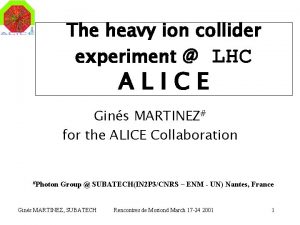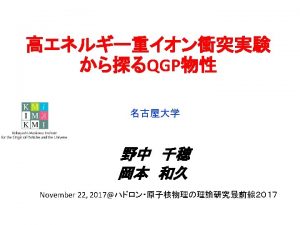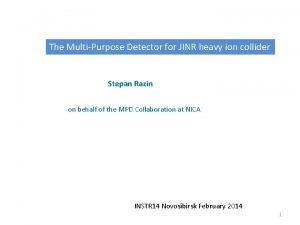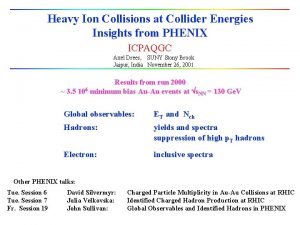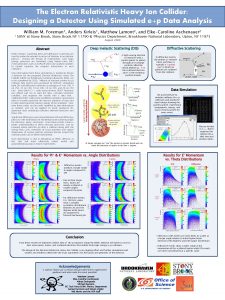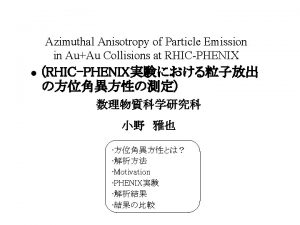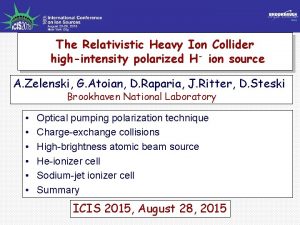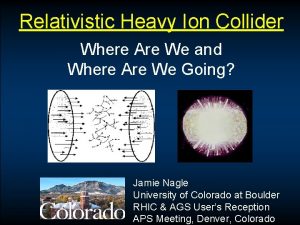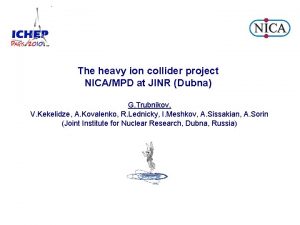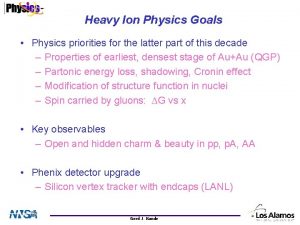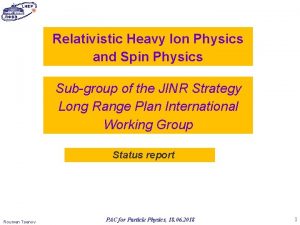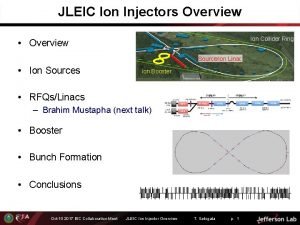Collider Detectors for Heavy Ion Physics W A





















































- Slides: 53

Collider Detectors for Heavy Ion Physics W. A. Zajc Columbia University Thanks to: Y. Akiba, M. Baker, D. Cebra, J. Dodd, Y. Fisyak, T. Hallman, M. Lisa, D. Lynn, J. Schukraft, J. Thomas, F. Videbaek, S. White 15 -Nov-99 W. A. Zajc 1

Outline l 2 Heavy Ion Collider(s) Previous q RHIC q LHC q l RHIC Program PHOBOS q BRAHMS q STAR q PHENIX q l LHC (CMS) q ALICE q 15 -Nov-99 W. A. Zajc

RHIC l l l 3 RHIC = Relativistic Heavy Ion Collider Located at Brookhaven National Laboratory Schedule: q q 15 -Nov-99 Commissioning: Jul-Aug, 1999 First physics run: ~Feb-00 through Aug-00 W. A. Zajc

RHIC Specifications l l 3. 83 km circumference Two independent rings q q l l 120 bunches/ring 106 ns crossing time Capable of colliding ~any nuclear species on ~any other species 4 6 1’ 3 5 4 2 1 Energy: è 500 Ge. V for p-p è 200 Ge. V for Au-Au (per N-N collision) l Luminosity q q 15 -Nov-99 Au-Au: 2 x 1026 cm-2 s-1 p-p : 2 x 1032 cm-2 s-1 (polarized) W. A. Zajc

5 Making Something from Nothing l Explore non-perturbative “vacuum” by melting it Temperature scale è Particle production è Our ‘perturbative’ region is filled with q u gluons u quark-antiquark pairs è A Quark-Gluon Plasma (QGP) l Experimental method: Energetic collisions of heavy nuclei l Experimental measurements: Use probes that are q q Auto-generated Sensitive to all time/length scales 15 -Nov-99 W. A. Zajc

6 What’s Different from “Ordinary” Colliders? l Obviously: Multiplicities q (Cross sections) q l But also: Hermeticity requirements q Rates q Low p. T physics q High p. T physics q Signals q 15 -Nov-99 W. A. Zajc

Hermeticity l A key factor in “most” collider detectors q q q l 7 Goal of essentially complete event reconstruction Discovery potential of missing momentum/energy now well established Of course this due to manifestation of new physics via electroweak decays In heavy ion physics d. Nch/dy ~ 1000 è exclusive event reconstruction “unfeasible” q But q u Seeking to characterize a state of matter u Large numbers statistical sampling of phase space a valid approach 15 -Nov-99 W. A. Zajc

Low p. T matters l 8 l Heavy ion physics takes Search for a phase transition place in phase space in hadronic matter q q Characteristic scale LQCD ~ 200 Me. V Flavor dynamics crucial both to transition and to its signatures q Coordinate space as important as momentum space q Measure via identical particle correlations (aka HBT ) Low p. T Particle Identification (PID) is crucial to QGP Physics 15 -Nov-99 W. A. Zajc

PID Techniques 9 The usual textbook examples… l Time-of-flight BRAHMS, PHOBOS, PHENIX l d. E/dx (in 1/b 2 region) PHENIX, PHOBOS, STAR l Cerenkov q Threshold (PHENIX), BRAHMS q RICH BRAHMS, PHENIX, STAR 15 -Nov-99 W. A. Zajc

(PID) Acceptances PHOBOS Acceptance 10 BRAHMS Acceptance STAR Acceptance 15 -Nov-99 W. A. Zajc

Tracking l l 11 Occupancies are typically 2 -15% More importantly, large number of tracks per event è Maximal projective ambiguities è Space points are essential q BRAHMS TPC q PHOBOS Si Pixels q PHENIX Pad Chambers q STAR TPC, Si Drift 15 -Nov-99 W. A. Zajc

Jet Physics at RHIC l Tremendous interest in hard scattering (and subsequent energy loss in QGP) at RHIC q q l 12 Predictions that d. E/dx ~ (amount of matter to be traversed) Due to non-Abelian nature of medium But: q q “Traditional” jet methodology fails at RHIC Dominated by the soft background: u For a typical jet cone R = 0. 33 (R 2 = DF 2 + Dh 2) have u l <n. SOFT> ~ 64 <ET> ~ 25 Ge. V Fluctuations in this soft background swamp any jet signal for p. T < ~ 40 Ge. V: Solution: q q Let R ~0 (PHENIX Dh x Df = 0. 01 x 0. 01) Then use high p. T leading particles 15 -Nov-99 W. A. Zajc

RHIC Luminosity l l l 13 It’s high! It’s an equal opportunity parton collider: Can accelerate essentially all species q q q Designed for p-p to Au-Au Asymmetric collisions (esp. p-A) allowed Good news / bad news: u u Permits many handles on systematics Permits in situ measurements of “background” p-p and p-A physics èDetectors must handle unparalleled dynamic range in rates and track densities 15 -Nov-99 W. A. Zajc

Other Differences l Event characterization q q q l 14 Impact parameter b is well-defined in heavy ion collisions Event multiplicity predominantly determined by collision geometry Characterize this by global measures of multiplicit and/or transverse energy b Models q HEP has SM èReliable predictions of baseline phenomena q HI has only Sub-SM’s… u Even the baseline physics at RHIC and beyond is intrinsically unknown 15 -Nov-99 W. A. Zajc

15 Design Guidelines for QGP Detection Question: How to proceed with experimental design when (Partial) answers: l The QGP phase transition will not be “seen” at RHIC Instead it will emerge as a consistent framework for describing the observed phenomena ê Avoid single-signal detectors q l There are no* cross sections at RHIC Except s. GEOM ~ few barns s. CENTRAL ~ (1 -10)% s. GEOM but s. QGP ~ s. CENTRAL ? ? ê Preserve high-rate and triggering capabilities l Expect the unexpected High gluon density production of exotics? q Color topology high anti-baryon production? q New vacuum large isospin fluctuations? ê Maintain flexibility as long as $’s allow q 15 -Nov-99 W. A. Zajc

Approaches to QGP Detection 1. Deconfinement 4. Strangeness and Charm Production R(U) ~ 0. 13 fm < R(J/Y) ~ 0. 3 fm < R(Y ’ ) ~ 0. 6 fm Production of K+, K- mesons: ê Electrons, Muons ê 2. Chiral Symmetry Restoration Mass, width, branching ratio of F to e+e-, K+K- with d. M < 5 Mev: ê Electrons, Muons, Charged Hadrons Baryon susceptibility, color fluctuations, antibaryon production: ê Charged hadrons DCC’s, Isospin fluctuations: ê Photons, Charged Hadrons 3. Thermal Radiation of Hot Gas Prompt g, Prompt g * to e+e-, m+m - : ê Photons, Electrons, Muons 15 -Nov-99 16 Hadrons Production of F, J/Y, D mesons: ê Electrons, Muons 5. Jet Quenching High p. T jet via leading particle spectra: ê Hadrons, Photons 6. Space-Time Evolution HBT Correlations of p± p±, K± K± : ê Hadrons Summary: Electrons, Muons, Photons, Charged Hadrons W. A. Zajc

Screening by the QGP 17 In pictures: 15 -Nov-99 W. A. Zajc

PHOBOS 18 An experiment with a philosophy: q Global phenomena èlarge spatial sizes èsmall momenta q Minimize the number of technologies: u All Si-strip tracking u Si multiplicity detection u PMT-based TOF q 15 -Nov-99 Unbiased global look at very large number of collisions (~109) W. A. Zajc

PHOBOS Design 15 -Nov-99 19 W. A. Zajc

PHOBOS Details l Si tracking elements q q l 15 -Nov-99 20 15 planes/arm Front: “Pixels” (1 mm x 1 mm) Rear: “Strips” (0. 67 mm x 19 mm) 56 K channels/arm Si multiplicity detector q 22 K channels q |h| < 5. 3 W. A. Zajc

PHOBOS “Results” 15 -Nov-99 21 W. A. Zajc

BRAHMS 22 An experiment with an emphasis: q q Quality PID spectra over a broad range of rapidity and p. T Special emphasis: u Where do the baryons go? u How is directed energy transferred to the reaction products? q 15 -Nov-99 Two magnetic dipole spectrometers in “classic” fixed-target configuration W. A. Zajc

BRAHMS Acceptance l 23 Combination of q q q Tracking Time-of-Flight Cerenkov provides broad PID in y-p. T l Small dipole apertures è narrow in f BRAHMS Acceptance 15 -Nov-99 W. A. Zajc

BRAHMS Details 24 TOF Module situ RICH q q 15 -Nov-99 TPC in C 4 F 10 Multi-anode PMT readout W. A. Zajc

BRAHMS “Results” 15 -Nov-99 25 W. A. Zajc

STAR l An experiment with a challenge: q Magnet Coils TPC Endcap & MWPC 26 Track ~ 2000 charged particles in |h| < 1 Time Projection Chamber Silicon Vertex Tracker FTPCs ZCal Endcap Calorimeter Vertex Position Detectors Barrel EM Calorimeter Central Trigger Barrel or TOF RICH 15 -Nov-99 W. A. Zajc

STAR Challenge 15 -Nov-99 27 W. A. Zajc

STAR Design 15 -Nov-99 28 W. A. Zajc

STAR Reality 15 -Nov-99 29 W. A. Zajc

STAR TPC Readout l l 30 12 sectors/side Large pads for good d. E/dx resolution in the Outer sector Small pads for good two-track resolution in the inner sector ~137 K channels 60 cm 190 cm 15 -Nov-99 W. A. Zajc

STAR SVT 31 One ladder installed for next running period 15 -Nov-99 W. A. Zajc

STAR EMC 32 Four modules installed for next running period 15 -Nov-99 W. A. Zajc

STAR TPC Data 33 From RHIC commissioning run Looks like collisions! But not beam-beam collisions 15 -Nov-99 W. A. Zajc

STAR “Results” 34 Demonstrate large hadronic rates from: F yield from ~12 minutes of running Large acceptance ~ 1 count per hour limit coupled with Large multiplicities (Assuming central triggers ) 15 -Nov-99 W. A. Zajc

35 PHENIX l l An experiment with something for everybody A complex apparatus to measure q q q Muon Arms West Arm Hadrons Muons Electrons Photons Executive summary: q Global MVD/BB/ZDC 3 station CSC 5 layer Mu. ID (10 X 0) p(m)>3 Ge. V/c South muon Arm High resolution High granularity 15 -Nov-99 Coverage (N&S) -1. 2< |y| <2. 3 -p < f < p DM(J/y )=105 Me. V DM(g) =180 Me. V East Arm Central Arms Coverage (E&W) -0. 35< y < 0. 35 30 o <|f |< 120 o DM(J/y )= 20 Me. V DM(g) =160 Me. V North muon Arm W. A. Zajc

PHENIX Design 15 -Nov-99 36 W. A. Zajc

PHENIX Reality 37 January, 1999 15 -Nov-99 W. A. Zajc

PHENIX Technologies l Event Characterization q q l Si strips and pads (MVD) Cerenkov (Beam-Beam) Tracking q Central Arms u u u q q q Time-of-Flight scintillators d. E/dx (TEC) See Friday’s talk by A. Frawley RICH TOF in Em. Calorimetry q q 15 -Nov-99 Cathode Strip Chambers (mu. Tr) Iarocci Tubes (mu. ID) Particle Identification q l Drift Chambers Pad Chambers Time Expansion Chamber (TEC) Muon Arms u l 38 Lead-scintillator (Pb. Sc) Pb-glass (Pb. Gl) W. A. Zajc

PHENIX PID 39 Rely on a variety of techniques to q Perform p/K/p… separation over a broad range u Time-of-flight in Beam-Beam/TOF-wall combination u Time-of-flight in Beam-Beam/Em. Cal combination u Use RICH above pion threshold ~ 4 Ge. V/c q Achieve e/p rejection in excess of 103 u RICH u TEC d. E/dx u Em. Cal shower shape, E/p match 15 -Nov-99 W. A. Zajc

PHENIX PID via TOF l 40 Superb Particle Identification for hadrons: q q Measure time difference between Beam (START) counters and “TOF” wall or Em. Cal elements. Beam-Beam: 2 x 64 Cerenkov radiators + PMT’s u s ~ 50 ps u q Time-of-Flight (TOF) wall: ~ 2000 PMT’s reading out ~1000 “slats” u s ~ 80 ps u q Em. Cal: Both Pb. Sc and Pb. Gl have timing capability (greatly extends coverage) u s(Pb. Sc) ~ 300 ps u s(Pb. Gl) ~ 400 ps u 15 -Nov-99 W. A. Zajc

41 PHENIX PID via Cerenkov Key Features: u u u 15 -Nov-99 Ring imaging Cherenkov with gaseous radiator Radiator gas: Most hadrons do not emit Cerenkov light ethane (n = 1. 00082) or methane (n = 1. 00044) Electron identification efficiency: RICH Close to 100% for a single electron with momentum less than ~ 4 Ge. V/c Pion rejection factor: > 103 for a single charged pion. PMT array with momentum less than ~ 4 Ge. V/c Ring angular resolution: ~ 1 degree in both q and f Two ring separation: ~ few degrees in both q and f mirror Cerenkov photons from e+, e- are detected by an array of PMTs PMT array Central Magnet Electrons emit Cerenkov light in RICH gas volume W. A. Zajc

42 PHENIX PID via d. E/dx q q Additional quality PID information, especially for electron/hadron rejection, from energy loss measurements in Time Expansion Chamber: Key parameters: u Total of 29, 312 channels on day 1. 42, 944 channels after upgrade. u Determines particle species using d. E/dx information e / p < 2% at 500 Me. V/c with Xe gas e/ p ~ 5% at 500 Me. V/c with P 10 gas. i 15 -Nov-99 W. A. Zajc

PHENIX “Results” 43 High p. T hadrons: Vector mesons: q Superb e/p rejection q q q Very fine segmentation High rate capability Excellent momentum resolution 15 -Nov-99 W. A. Zajc

Di-Muon Physics 44 Much larger acceptance for vector mesons in either of the PHENIX muon arms è Physics rates compare well to existing fixed-target ``standards'': l Compilation by M. Leitch 15 -Nov-99 W. A. Zajc

RHIC ZDC’s l l ZDC Zero Degree Calorimeter Goals: q q l Uniform luminosity monitoring at all 4 intersections Uniform event characterization by all 4 experiments Process: q q 15 -Nov-99 45 Correlated Forward-Backward Dissociation stot = 11. 0 Barns (+/- few %) W. A. Zajc

RHIC Spin Physics l 46 A polarized hadron collider is uniquely suited to some spin measurements: q DG via u Direct photons u Hign p. T pions u J/Y production via q u W+/W- production u Polarized Drell-Yan l RHIC has been equipped q q To provide polarized beams of protons To make spin measurements of same in (at least) PHENIX and STAR 15 -Nov-99 W. A. Zajc

LHC l Heavy ion capabilities q l Pb+Pb at 5. 5 Te. V / nucleon (~ 25 times RHIC energy) Conditions q q q l 47 ~ 1027 cm-2 s-1 125 ns crossing time d. Nch/dy ~ 8000 Two experiments q q CMS ALICE (dedicated) 15 -Nov-99 W. A. Zajc

ALICE l l l 48 A large heavy ion experiment Both hadronic and muon capabilities Based on L 3 infrastructure 15 -Nov-99 W. A. Zajc

ALICE Design TOF RICH 49 Muon Tracker TPC Inner Tracking System PHOS 15 -Nov-99 W. A. Zajc

ALICE Technologies 50 Inner Tracking System 6 layers of Si drift, pixel, strip TPC |n| < 0. 9 (field cage prototype) TOF See Friday’s talk by M. Spegel 160 k PPC (150 m 2) RICH Cs. I photocathode (prototype in STAR) PHOS Pb-W 04 crystals Muon Tracking Cathode pad chambers 15 -Nov-99 W. A. Zajc

CMS l Use the superb muon resolution of CMS to study q q Upsilon sytematics Jet quenching opposite Z 0 m+m- 15 -Nov-99 51 See today’s talk by J. L. Faure W. A. Zajc

CMS and ALICE Muons 52 (Summary by G. Paic) 15 -Nov-99 W. A. Zajc

Summary l 53 The RHIC heavy ion community is ready to begin experiments with a set of detectors designed for the first dedicated heavy ion collider Great challenges in u Segmentation u Dynamic range u Data volumes have been or soon will be met l 15 -Nov-99 Even greater challenges await the heavy ion program at the LHC(!) W. A. Zajc
 Frontier detectors for frontier physics
Frontier detectors for frontier physics Ratey rational functions
Ratey rational functions Heavy ion
Heavy ion Ejemplo de fuerza ion ion
Ejemplo de fuerza ion ion Uniones intermoleculares
Uniones intermoleculares Induced dipole induced dipole interaction
Induced dipole induced dipole interaction Ejemplo de fuerza ion ion
Ejemplo de fuerza ion ion Fcc collider
Fcc collider International linear collider
International linear collider Unity sphere collider
Unity sphere collider Bnl
Bnl Hadron collider
Hadron collider Muon collider
Muon collider Hadron collider
Hadron collider Fcc collider
Fcc collider Cern future circular collider
Cern future circular collider Language
Language Rhmd: evasion-resilient hardware malware detectors
Rhmd: evasion-resilient hardware malware detectors What is streaming potential
What is streaming potential Hplc detector types
Hplc detector types Feature detectors
Feature detectors Vhv voltage detectors
Vhv voltage detectors Where are feature detectors located
Where are feature detectors located Giant wave detectors murmurs universe
Giant wave detectors murmurs universe Diagnosing error in object detectors
Diagnosing error in object detectors Photo detectors
Photo detectors Kinesthesis and vestibular sense
Kinesthesis and vestibular sense Gravitational wave hear murmurs universe
Gravitational wave hear murmurs universe What is thermal detector
What is thermal detector Nuclear detectors
Nuclear detectors Heavy flavor physics
Heavy flavor physics Physics ia simulation ideas
Physics ia simulation ideas Modern physics vs classical physics
Modern physics vs classical physics University physics with modern physics fifteenth edition
University physics with modern physics fifteenth edition Byggprocessen steg för steg
Byggprocessen steg för steg Karttecken sten
Karttecken sten Luftstrupen för medicinare
Luftstrupen för medicinare Mindre än tecken
Mindre än tecken Rbk-mätning
Rbk-mätning Formel för lufttryck
Formel för lufttryck Elektronik för barn
Elektronik för barn Underlag för särskild löneskatt på pensionskostnader
Underlag för särskild löneskatt på pensionskostnader Borra hål för knoppar
Borra hål för knoppar Smärtskolan kunskap för livet
Smärtskolan kunskap för livet Bris för vuxna
Bris för vuxna Vad är ett minoritetsspråk
Vad är ett minoritetsspråk Trög för kemist
Trög för kemist Delegerande ledarstil
Delegerande ledarstil Ellika andolf
Ellika andolf Datorkunskap för nybörjare
Datorkunskap för nybörjare Toppslätskivling effekt
Toppslätskivling effekt Returpilarna
Returpilarna Redogör för vad psykologi är
Redogör för vad psykologi är Mat för idrottare
Mat för idrottare


